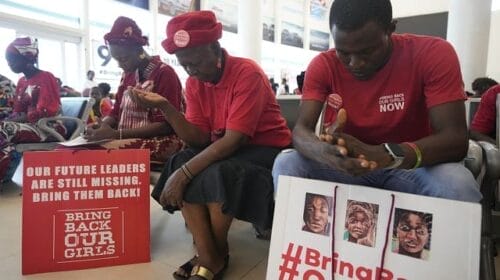DRC: Search for missing loved ones begin in Goma after Saturday’s volcanic eruption

The eruption of Nyiragongo volcano in Goma, east of the Democratic Republic of Congo on Saturday forced thousands of people to leave their homes. With the help of a local NGO, some of them found refuge in the New Apostolic Church in the town of Sake, more than 30 kilometres from Goma. But there are many still missing.
“I came from Goma, Buhene to be precise, there was fire everywhere and we had to flee. When I arrived here, I had my children with me but some of them got lost, I can’t find them anymore”. Odette Yanfanshize, one of the displaced persons at the church said.
For the local NGO MUMAMA, the situation is overwhelming.
“Our help is not enough, we are close to being overwhelmed. The city of Sake is going to be overpopulated. The displaced people are starting to outnumber the locals, and unfortunately we can’t do anything for them, the volcano took us all by surprise. We are helping them to the extent of our capacity and we ask for support from national and international organisations to help these displaced people urgently.” said Charlotte Mwango, coordinator of the local NGO.
Even as the search continues for the missing, powerful aftershocks from the Mount Nyiragongo volcano rocked Goma on Tuesday as the death toll from the disaster climbed to 32 and thousands were feared homeless.
Three days after Africa’s most active volcano roared back into life, spewing lava that reached the outskirts of the city of 1.5 million, tremors were shaking the region every 10 to 15 minutes.
And two major cracks, stretching up to several hundred metres (yards) long and dozens of centimetres (roughly two feet) wide in places in some places, opened up near the city’s main hospital and on a major highway near the airport, worrying residents who have only just returned home after Saturday’s eruption.
“We don’t know what to do — we’re in a quandary, there’s no instructions from the authorities, even though everything is moving,” said local resident Furaha Nyirere, visibly anxious.
A three-storey building partially collapsed under the repeated strain of the aftershocks, seriously injuring at least seven people, police said.
“We are all living in fear of a fresh eruption,” a local official from an international organisation told AFP. “The aftershocks are very intense. A lot of people slept outside under mosquito nets, scared that their homes were going to collapse. There are cracks in the walls of our office,” the official stressed.
Across the nearby border, the Rwanda Seismic Monitor said it had detected a 5.3 magnitude earthquake in the region at 0903 GMT, as well as a 4.6 magnitude tremor an hour earlier.
Goma, a city on the shores of Lake Kivu, lies just 12 kilometres (about seven miles) from Mount Nyiragongo. Tens of thousands of residents fled in panic, many of them to Rwanda, when the much-dreaded volcano began erupting on Saturday evening.
Two rivers of molten rock flowed from the volcano at a height of 1,800 metres (5,900 feet). One headed towards Goma, stopping at the very outskirts of the city.
– Fears of fresh eruption –
It engulfed homes in its wake, smothering the surrounding area with suffocating gas and cutting off the road between Goma and Butembo, the main highway in North Kivu province.
“Thirty-two people died in incidents linked to the eruption, including seven people killed by lava and five asphyxiated by gases,” the UN refugee agency UNHCR said in Geneva.
“The lava flow stopped on Sunday, but there have been repeated earthquakes since the eruption and the lava lake in the volcano’s crater appears to have refilled, prompting fears of new fissures opening or another eruption.”
The previous toll, drawn from NGOs and other sources, was 20. Five people died from suffocation on Monday after they tried to cross the cooling lava some 13 kilometres north of Goma, civil society leader Mambo Kawaya told AFP.
A so-called strato-volcano nearly early 3,500 metres (11,500 feet) high, Nyiragongo straddles the East African Rift tectonic divide. Its last major eruption, in 2002, claimed around 100 lives.
– Need for water –
Raphael Tenaud, deputy head of the International Committee of the Red Cross (ICRC) delegation in Goma, said lava had destroyed four large villages and damaged 12 others.
Humanitarian groups estimate that between 900 and 2,500 dwellings were destroyed representing around 5,000 newly homeless people, he said.
Some 25,000 people fled on Saturday and Sunday, Tenaud said.
“Many of these displaced people have started to return to Goma, some have even come back to the site of the disaster, near the lava flow,” he said. “Some are still displaced as they are afraid to come back,” he added.
Damage to a reservoir has potentially affected water supplies for around half a million people, Tenaud said.
“The main problem will be a problem of access to potable water and all the consequences that may stem from that,” he said, referring to the risk of disease.
The ICRC will revive a disused pumping station to draw water, and water will also be distributed by tanker truck, Tenaud added.
Most of the hospitals in the east of the city have been closed, although four hospitals in the west are functioning, he said.
Another problem is that of children who became separated from their parents in the panic, with the Red Cross receiving 735 requests for help.





